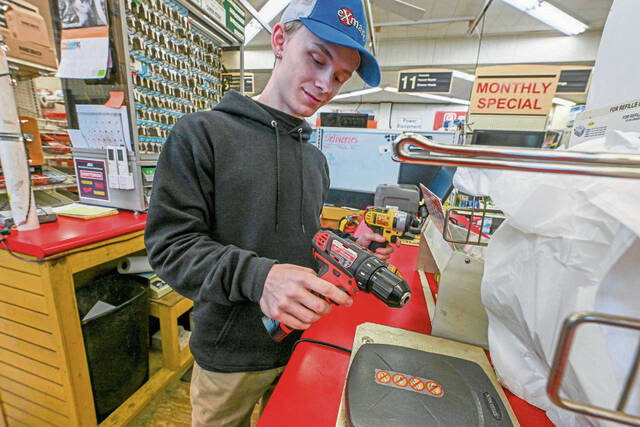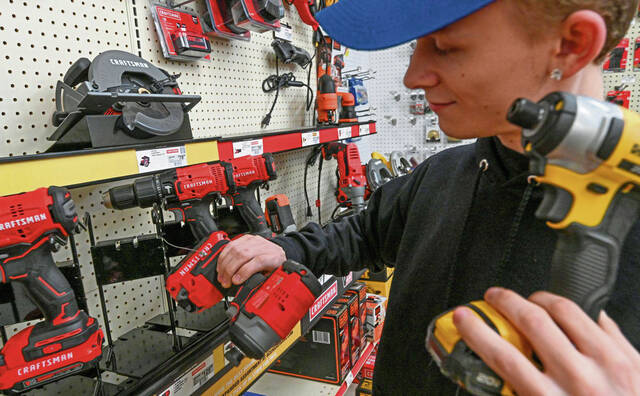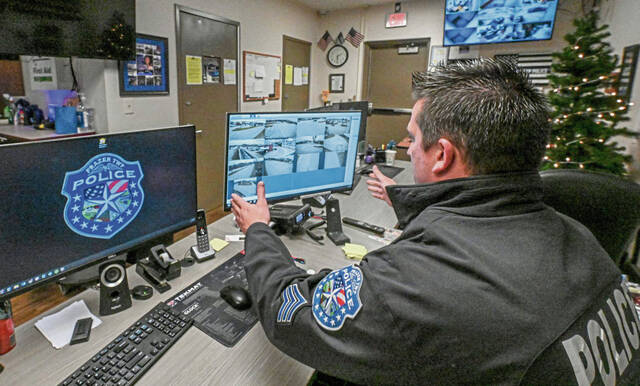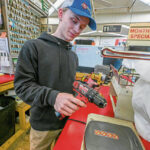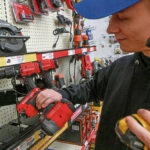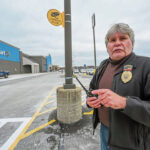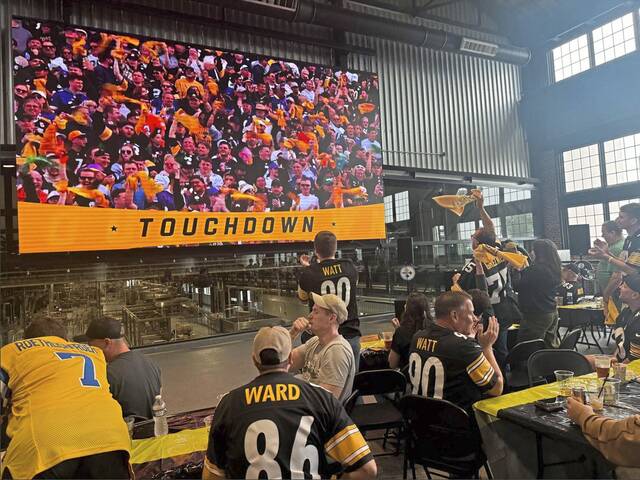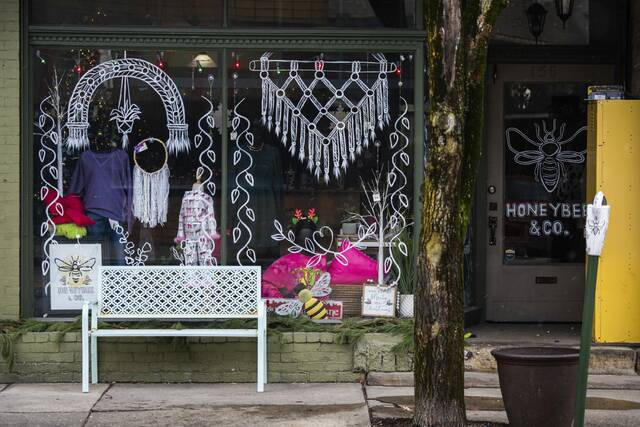Holiday shopping in some local stores will look a little different this year.
With reports of retail theft on the rise, some retailers are placing some inventory under lock and key, requiring customers to contact a store employee to access certain merchandise.
The measures are aimed at reining in what experts say is eating away at companies’ profits.
“As retail crime continues to escalate, retailers are doing everything they can to protect their merchandise from theft,” said David Johnston, the National Retail Federation’s vice president of asset protection and retail operations. “One prevention tactic includes locking up inventory so retailers can secure the products for sale to consumers while preventing it from being stolen.”
Findings from this year’s NRF National Security Survey include an increase in the average “shrink percentage,” to 1.6% in 2022 from 1.4% in 2021. Shrink percentage measures how much inventory is lost due to theft, damage or errors.
The increase represents more than $112 billion in total reported losses — up from $94 billion in 2021, according to the NRF.
Two-thirds of the reported losses can be attributed to internal and external theft, Johnston said.
Retailers are aware some preventive tactics may impact the shopping experience, but securing the merchandise keeps it on their shelves, Johnston said.
“Retailers must balance the availability of product versus the inconvenience for customers,” he said. “While locking up merchandise has impeded some buyers, it has become necessary to several retailers due to the increasing theft and loss.”
Retail theft at the sprawling Pittsburgh Mills shopping complex in Frazer has not decreased since stores have started to lock up more of their merchandise, said Frazer police Chief Terry Kuhns.
Kuhns estimates his department files at least 15 criminal complaints for retail theft per month. A prevalent form of retail theft is what he called “under ringing,” where shoppers don’t scan all of their items at the self-checkout.
There is an increase in retail theft incidents from Thanksgiving until the end of the year, Kuhns said. He said his department also has seen an increase in retail theft since the Walmart at The Waterworks shopping center near Aspinwall closed last year.
His officers are able to solve a “great percentage” of those incidents, he said, noting the helpfulness of surveillance cameras and license plate readers in and around the Mills complex.
“I have zero tolerance for professional thieves,” Kuhns said.
The Frazer Police Department handles people in need — who take items such as food, milk, diapers or other life-sustaining items — differently than people who steal big-ticket items or do so out of greed, Kuhns said. His officers direct those in need to programs that provide assistance.
Walmart spokesperson Robert Arrieta said the company doesn’t discuss details of security measures or loss numbers. Walmart is focused on taking steps to protect its employees, customers and merchandise, he said.
“We understand retailers can’t solve this alone,” Arrieta said. “While we appreciate law enforcement’s partnership in this challenge, the communities most often impacted by retail crime must insist that the laws in place are enforced.
“We’re actively managing the issue on multiple fronts across the country,” he said. “However, we understand this isn’t a problem we can solve alone. We need communities impacted to insist that enforcing the law be a top priority.”
Other retailers have closed locations, trimmed operating hours or reduced or altered in-product selection because of theft.
A Macy’s spokesperson said in a statement that the store prioritizes the safety of its customers and employees.
“We achieve this by deploying asset protection teams and collaborating with security and law enforcement. We are testing the use of advanced technology, reporting and tools as well as optimizing our asset protection staff to focus on high-risk areas to ensure a secure shopping experience,” the spokesperson said.
With about two dozen Walgreens stores within a 30-mile radius of New Kensington, company spokesman Marty Maloney said Walgreens is taking measures such as installing anti-theft devices to deter retail crime.
“These steps are taken in response to theft data. And for that reason only, these additional security measures allow us to improve on-shelf availability of products to customers,” Maloney said. “We also continue to partner with others across the retail industry, as well as law enforcement, elected officials and community leaders to improve shrink trends.”
Stores can choose to call police to address retail theft or submit a fine to the shoplifter through the state Civil Recovery Act, said Greensburg police Chief Chuck Irvin. If the fine is not paid, the case moves to court, he said.
Retail theft counts as a first-degree misdemeanor if it is the second offense, or if the stolen merchandise is valued at $150 or more, said state Trooper Cliff Greenfield. A third or subsequent offense, regardless of the stolen merchandise’s value, is a felony.
State police respond to retail theft in municipalities that don’t have their own full-time police forces, Greenfield said, including Hempfield and Unity.
From Jan. 1 to the end of September, state police responded to 120 retail theft calls in Westmoreland County, according to the state police database.
Such calls have been increasing every year this decade: Troopers responded to 198 calls in 2022, 139 in 2021 and 130 in 2020 — the earliest year included in the database.
“As a patrol trooper, retail theft is a very common incident that you’re called to investigate,” Greenfield said.
The Greensburg Police Department received 24 calls relating to retail theft in 2020, 18 calls in 2021 and 22 last year. Irvin said he hasn’t noticed an increase in retail theft complaints this year, but added there is an occasional spike around the holidays.
In the past few weeks, there have been two thefts from Shop ’n Save grocery stores where a shoplifter fled, Irvin said. They have yet to be identified by video and photos provided by the stores.
“I know in Westmoreland County, we see some theft organizations move through from time to time — often from the New York City area or Philadelphia area,” Irvin said. “These types of organizations move across the nation. Westmoreland is just not seeing the blatant theft issues that you see pop up on the news programs from major cities.”
A woman was apprehended by Latrobe police for allegedly shoplifting thousands of dollars worth of items from a Shop ’n Save store across an extended period of time, Chief Richard Bosco said in a Facebook post Tuesday.
The department is working closely with local retailers and residents to prevent theft, Bosco said. He urged residents to report suspicious behavior.
Doug Arnold Jr. of Arnold’s Hardware in Harrison said his family’s store combats retail theft in three ways: having employees up front, using surveillance cameras, and having an anti-theft system for more valuable items.
The store doesn’t lock up any of its items, but it does place a wire around certain power tools. If the wire breaks, it sets off an alarm, Arnold said.
“In a hardware store, it’s hard because people want to pick up the item and hold it in their hands. If they’re looking at a nut or a bolt, they definitely want to be able to hold it. … It’s kind of a different customer base for a hardware store,” Arnold said.
Retail theft really isn’t an issue at the store, he said, because many patrons are repeat customers and have a good relationship with management.


